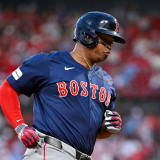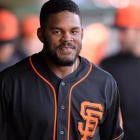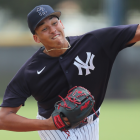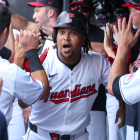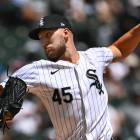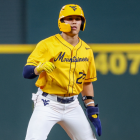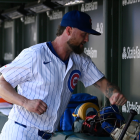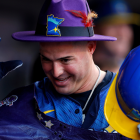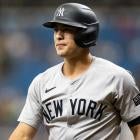With the regular season concluding, we've decided to take a look at each team's future -- not by using a crystal ball or other psychic abilities, but by evaluating their farm systems. Below you'll find our ranking of the top five prospects in the organization -- sorted by perceived future potential -- as well as five other players who fit various categories. Those categories are:
2020 contributor: A player who is likely to play a role for the big-league team next season.
Analyst's pick: A player who is a strong statistical performer and/or whose underlying measures are better than the scouting reports suggest.
Riser: A player on the way up.
Faller: A player on the way down.
One to watch: An interesting player to keep in mind (for whatever reason).
These rankings were compiled after talking with various industry sources about the systems (and players) in question. It should be acknowledged that this process is more art than science, and that there are limits to ordinal rankings. Still, it's an intuitive system, and our hope is that the write-ups will answer any questions by providing additional context and analysis of each player -- such as their pluses and minuses; the risk factors involved; and their estimated arrival date.
One last word on eligibility: we're following MLB's rookie guidelines by disqualifying any player with more than 130 big-league at-bats or 50 innings pitched.
The San Francisco Giants don't have the best farm system by any means, but they do have a few high-ceiling prospects who could in time make this system look a lot better than it does now.
1. Heliot Ramos, OF
For years, Heliot Ramos has flirted with the top spot on prospect lists. Now, he's earned it here following a season in which he hit .306/.385/.500 with 13 homers in High-A at 19.
Ramos, who turned 20 in September, didn't fare quite as well in 25 Double-A games, striking out in 31 percent of his plate appearances. He gets a pass because he was roughly five years younger than the average batter in the league, per Baseball-Reference's calculations. (Plus it was 25 games during his first look at the level.)
There are some downsides to Ramos's game -- the previously referenced swing-and-miss and the likelihood he ends up in a corner rather than sticking up-the-middle -- but generally, this kind of offensive potency at such a young age against older competition bodes well for the future.
2. Marco Luciano, SS
The Giants signed Marco Luciano for $2.6 million in July 2018, and that could pay dividends.
Luciano has all the makings of a future power hitter: a projectable 6-foot-2 frame; good bat speed; and a swing with loft. In rookie ball, he homered 10 times in 146 at-bats and posted a .295 ISO. Yes, it's just rookie ball, but Luciano was also playing there as a 17-year-old. How his eye fares against more advanced pitching is to be seen, but so far so good.
Of course, Luciano's physical maturation could force him off shortstop in due time, depending on how he fills out and how is body handles the additional muscle. The Giants haven't tasked him with playing any other position yet -- and why would they? There's a chance he sticks there regardless, or at least that he remains on the left side of the infield.
If so -- and if Luciano's bat also progresses as expected -- he could become a star. There's considerable risk that he won't, but that's the warp and woof of teenage prospects.
3. Joey Bart, C
This is a spot or two lower than where most people would expect to see Joey Bart, the No. 2 pick in the 2018 draft and the presumed heir to Buster Posey. But there is good reason for it -- beginning with the upside offered by the pair above, and expanding into Bart's profile. The former should be obvious at this point, as for the latter … let's get to it.
Despite being a top draft pick, Bart's scouting reports don't feature a ton of high grades. As one team source noted, he's never been projected to have a plus hit tool -- he's a power-over-hit type who doesn't walk a ton -- and the only consistent "six" he's earned from their scouts is for his mitt.
Bart is a catcher, so that's a fine tool to receive your best grade in. There is some disagreement about how good he is at framing, however, which is important since it's more prevalent in a catcher's game than blocking a ball in the dirt or throwing out a baserunner. Some teams' internal metrics have Bart down as merely average, rather than plus or borderline elite.
Maybe those metrics are missing out, or maybe Bart can improve in that regard. But you have to trust the information at hand. That info suggests Bart is more likely to be solid than a star.
4. Logan Webb, RHP
A young draftee in 2014, Logan Webb will pitch next season at the ripe age of 23. He's likely to spend a healthy chunk of the year -- if not most or all of it -- in the majors.
After all, Webb has already made eight starts in the Show, giving him seven more than he made in Triple-A and just five fewer than he did in Double-A. Some of that disparity can be blamed on time missed due to injuries, as well as an 80-game suspension for a failed drug test that he received in May.
When Webb is on the mound he has the makings of a mid-rotation starter. He has a strong, sturdy frame that he's worked hard to develop, and a three-pitch arsenal that includes a 93 mph fastball, a swing-and-miss slider he can also throw in the zone, and an improving changeup.
The biggest key for Webb now is to keep himself on the active roster.
5. Hunter Bishop, OF
The young brother of Mariners outfielder Braden, Hunter Bishop became the 10th pick after a breakout season at Arizona State that saw him homer 22 times and hit .342/.479/.748.
Bishop is a high-grade athlete who was a two-sport star in high school. Predictably, he possesses an intriguing blend of raw power and speed that could one day make him a star-caliber performer. That, paired with his production, makes it reasonable to ask: why didn't he go earlier in the draft?
The answer is because some of the teams picking earlier had concerns as it pertains to the usability of Bishop's tools -- with a few throwing unfavorable comparisons to high-profile busts of days past. Some of the knocks include how he's likely to end up in left due to a substandard arm; how he consistently struck out more than he walked in college; and so on.
Bishop will likely remain a polarizing prospect for the foreseeable future.
2020 contributor: Mauricio Dubon, INF
Acquired at the deadline in exchange for Drew Pomeranz and Ray Black, Mauricio Dubon has a chance of being the Giants' most-days second baseman in 2020. He's a free-swinger who isn't likely to walk much, yet he has a good feel for contact and shows some mindfulness about his craft by varying his stride -- often leg-kicking, but sometimes going with a toe-tap instead. At minimum, Dubon should be a useful spare infielder who is already big-league-ready.
Analyst's pick: Sean Hjelle, RHP
Sean Hjelle is listed at 6-foot-11 and has the wingspan of a prehistoric bird of prey. He had carved up the lower minors until reaching Double-A, where he posted a 6.04 ERA in five starts. There's no sense panicking at this point. Rather, Hjelle still looks like at least a back-end starter whose size and release point could permit him to pitch beyond the sum of his parts -- and, presumably, terrorize his bullpen by placing things on the highest platform in the clubhouse.
Riser: Seth Corry, LHP
Lefty Seth Corry led the South Atlantic League in strikeouts by 16 despite having 20-plus fewer frames than the No. 2 and 3 finishers. Why isn't he in the top five? Because Corry's delivery includes some tics -- a hard, rigid front side and a dangling glove -- that contributes to below-average command. To wit, Corry walked more than four batters per nine innings. He'll pitch next season at 21, so maybe he can use the next few years to smooth out his mechanics.
Faller: Chris Shaw, 1B/OF
There was a time, not too long ago, when Chris Shaw was considered one of the better prospects in the system. Now? Shaw could be on his way out. He still has massive raw power, but the swing-and-miss he's displayed in his big-league cameos over the last two seasons has been comical -- he's whiffed on more than 46 percent of his swings in 82 trips to the plate. That's not going to work -- especially not given his substandard glove and wheels.
One to watch: Alexander Canario, OF
Alexander Canario hit .301/.365/.539 with nine home runs in 49 Low-A games as a teenager. Sure, he also fanned in a third of his plate appearances, which could prove to be the proverbial canary in the coal mine. But he won't turn 20 until May and he was more than a year and a half younger than his average competition. For now, here's to giving him some room to spread his wings -- who knows, he might just develop into a middle-of-the-order thumper.





